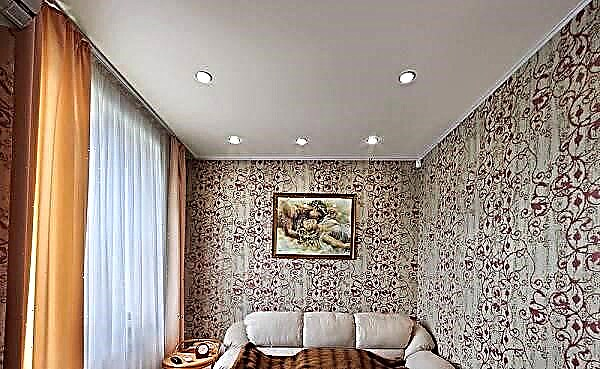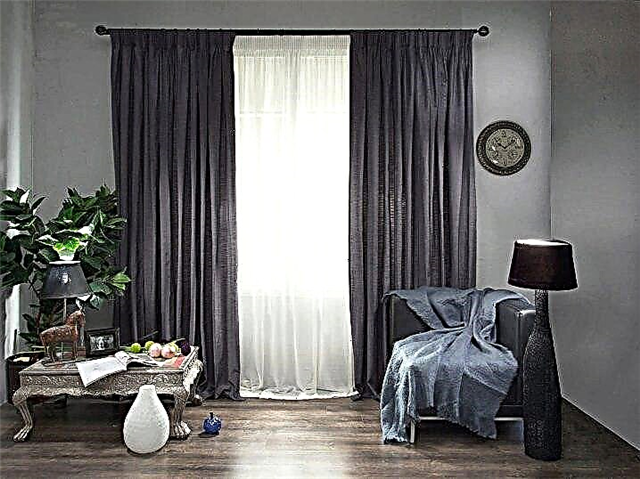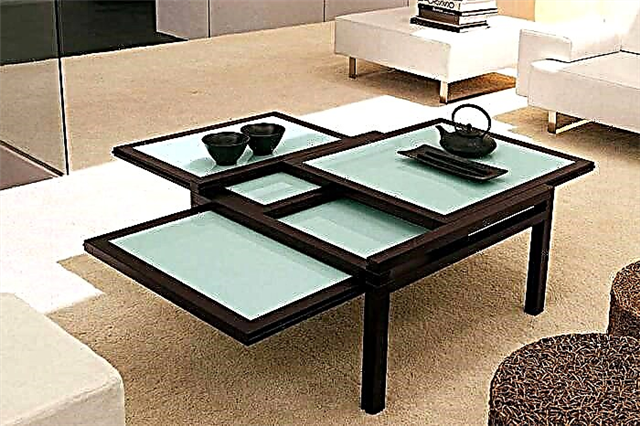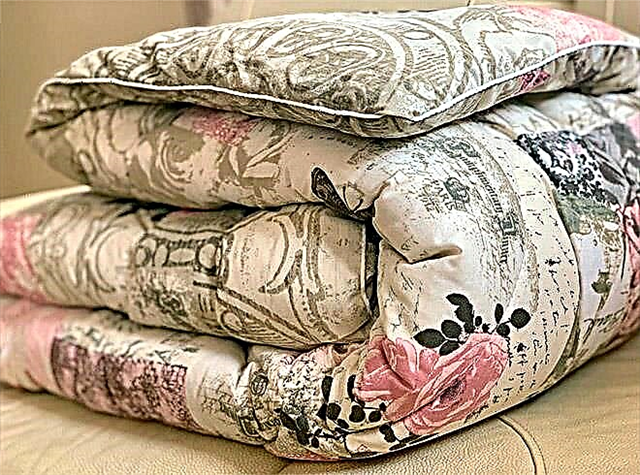
A person spends a large amount of time in a dream. And to make the sleep comfortable, you need to choose a high-quality and comfortable blanket that will warm you in cold times and protect against changes in room temperature. Cotton blankets are known firsthand from childhood, most often they are found in kindergartens, hospitals and other institutions. Before buying a blanket, you need to learn in detail about its significant characteristics, pluses and minuses.
Composition and features of cotton blankets
The blanket contains only natural materials:
- blanket filler - 100% natural combed cotton wool,
- the blanket cover can be made of teak, calico, calico, chintz, poplin, satin, satin or microfiber.
On sale you can also find products with combined cotton fillers and synthetic fibers in various percentages. Pay attention to the composition.
- It has a heavy weight, is not electrified and retains heat.
- It is comfortable to sleep under it at any time of the year.
- It is made only from natural materials.
- It is hypoallergenic, which is why it is great for those who have health problems.
- It does not have a static effect.
- Provides comfort and pleasant tactile sensations,
- The quality of the stitches gives a guarantee that the cotton wool will not be able to get lost in clods.
- With care, the blanket can last up to 30 years.
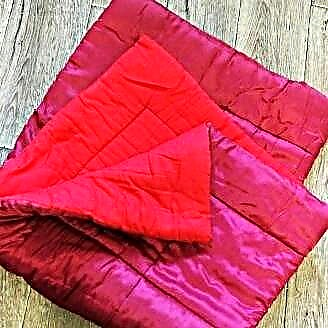
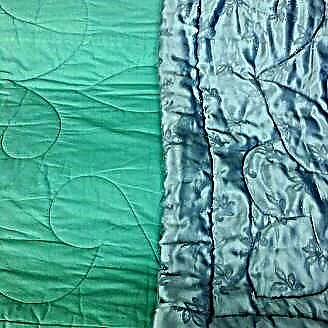 Photo: Soviet quilt wadded blanket (pr-v USSR)
Photo: Soviet quilt wadded blanket (pr-v USSR)Cotton Quilt: Pros and Cons
The advantages of a cotton blanket include:
- In winter it will not be cold under the covers, and in summer it will not be hot.
- 100% naturalness and quality.
- Low cost in comparison with blankets from other materials.
- Long life with proper care.
- It does not cause allergies.
- Do not inject.
- Not electrified.
- In the world of modern technology, cotton blankets no longer crumple.
Disadvantages of using a cotton blanket:
- The cotton wool filler has a large weight, not everyone will be comfortable.
- The difficulty in manual cleaning (due to severity) is not recommended for machine washing, and dry dry cleaning can lead to unaesthetic stains.
- It can easily absorb foreign odors.
- A natural product is a favorable environment for the appearance of insects (for example, bugs).
- It absorbs a large amount of moisture, which means it requires frequent drying of the blanket (1 time in 4 months) and beating.
Cotton Quilt Weight
The table shows the average weight values for cotton blankets.
| Dimension | Weight, kg |
| Baby | from 0.5 |
| 1.5 bedroom | from 1.5 to 5 |
| 2 bedroom | from 1.8 to 6 |
| Euro blanket | from 2 to 8 |
Dimensions
- Baby blanket, for babies - 110x140 cm,
- One and a half. For older children and an adult who sleeps alone - 140x205 cm,
- Double. For spouses who sleep in an embrace or for a person who sleeps alone in a large bed - 172x205 cm.
- Euro. For a couple who cannot always sleep close to each other - 200x220 or 220x240 cm.
How much is a cotton blanket, price
This blanket attracts with its relatively inexpensive cost, which depends on the size, cover material and stitching method:
- The smallest baby blanket can cost 350 rubles,
- A blanket 140x205 cm has a price of 500 rubles,
- A double sleeping blanket can be bought from 600 rubles,
- Euro-blankets are sold at a cost of 800 rubles.
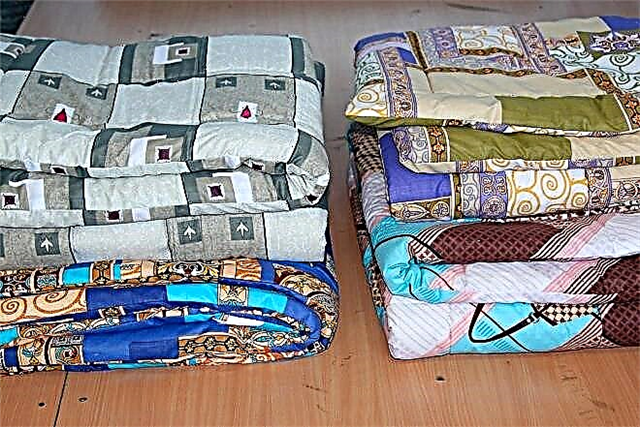
Customer reviews
As with any product, opinions are divided. Some people think that quilts are the last century. There are many modern materials that can create a comfortable temperature and at the same time not so heavy. But the other half claims that they will never exchange an environmentally friendly blanket for synthetics. Not a single blanket can give such warmth, and the thickness and heaviness does not bring them discomfort during sleep.
How to choose a cotton blanket
- The width of the blankets should be chosen according to the width of the bed and in accordance with the growth of the person who will sleep under him.
- Particular attention should be paid to the cover, since it is it that holds the filler inside, which means it must have sufficient density. Cotton should not be visible between the stitches and threads of the fabric.
- Read the information on the label. Care recommendations will tell you what quality the filler really is. If you can wash it at home, then this indicates a good quality product, since the manufacturer does not worry about the fact that the blanket may deteriorate after washing.
- So that subsequently the blanket does not seem uncomfortable, it is better to weigh it in your hand. If it seems unnecessarily heavy, then you should not buy it.
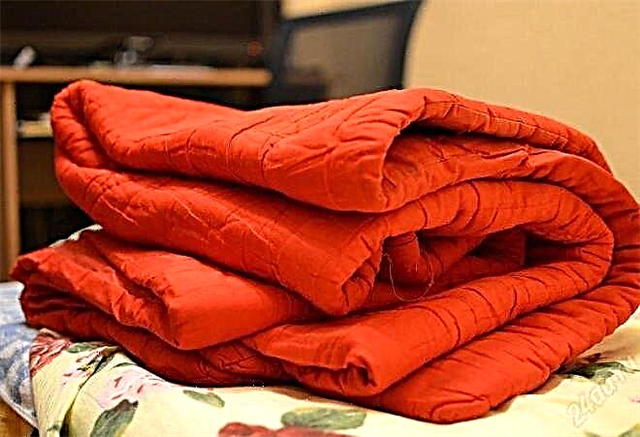
Vata is an environmentally friendly material, since there is no chemical treatment during production, which is an indisputable advantage for allergy sufferers. Cotton blankets for many years delight their owners, show their best properties and are of high quality. A warm blanket maintains a comfortable temperature at any time of the year, does not slip with gentle care, serves for many years and has a low price. Due to its qualities, products are the best option not only for home comfort, but also for hotels, resorts, hostels and other institutions.
Bird fluff
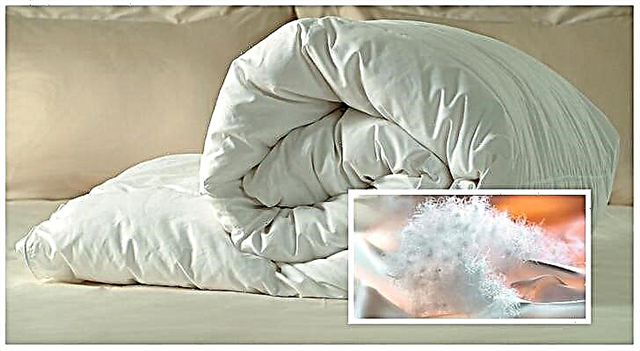
Goose down is the most popular and traditional natural filler of animal origin.
- High warming ability. The fluff is very warm and has excellent thermoregulation.
- Breathability. The downy filler passes air well, forming a comfortable microclimate under the blanket.
- Elasticity and non-resistance. The duvet quickly recovers and does not lose its magnificent shape for a long time.
- Light weight. No filler can compete with fluff lightness.
- Antistatic. Fluff is not electrified.
- Durability. The duvet lasts up to 20 years.
- Allergenicity. Down The ideal breeding ground for dust mites.
- Poor moisture exchange. Absorbing up to 45% moisture relative to its own weight, the fluff does not evaporate and quickly dries.
- High price. Blankets made of 100% fluff are the most expensive.
- Difficult care. Duvets need anti-mite treatment and special storage.
The quality of duvets is time-tested, and modern technology has brought it to a new level. Such a blanket will cost a lot, but its cost will pay off with a long service life.
Sheep's wool

The second most popular (after bird fluff) natural filler.
- The healing properties. Sheep wool has been used for centuries to treat osteochondrosis and muscle pain.
- The ability to warm with dry heat. The warming properties of sheepskin are second only to fluff and camel hair.
- Breathability. Air flows freely through the wool pad, keeping the temperature optimal for sleeping under the covers.
- High moisture exchange. Sheepskin absorbs and evaporates moisture perfectly, remaining dry.
- Antistatic. Sheep's wool does not accumulate static electricity and neutralizes its negative effect.
- Affordable price. This natural filler is cheaper than many types of synthetics.
- Allergenicity. Not only dust mites, but also animal wax can cause allergies to wool.
- Traceability. Sheep blankets are caked after 3-4 years of operation.
- A lot of weight. Heavier than sheep’s blankets are only cotton.
- Difficulty in leaving. For wool only dry cleaning is allowed.
Sheep blankets are popular all over the world because they are ideal for people who prefer the naturalness of animal raw materials in combination with affordable prices.
Camel's wool
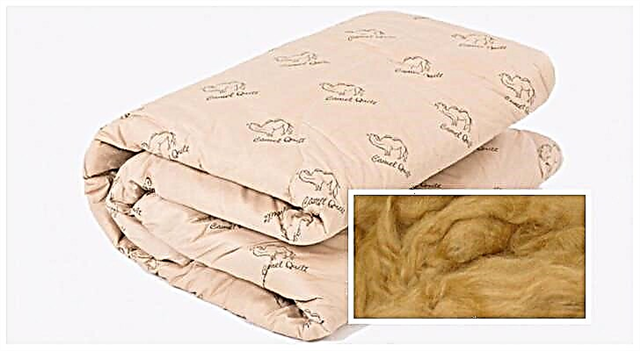
Camel hair in the East is as popular as sheep wool in the West, but the quality of camel filler is considered to be higher.
- The healing properties. Like sheep, camel hair warms with dry heat, reduces muscle pain and reduces the symptoms of a cold.
- Low thermal conductivity. Camel hair is as warm as down.
- Excellent moisture exchange. Camel filler perfectly evaporates and absorbs moisture.
- Breathability. It is impossible to sweat under the camel blanket.
- Durability. Camel blankets serve up to 30 years.
- Non-compliance. Camel hair is very elastic and holds its shape perfectly.
- Ease. A camel blanket is slightly heavier than a duvet.
- Antistatic. Camel hair is not electrified and neutralizes the effects of static electricity.
- Allergenicity. The scourge of all allergy sufferers - dust mites also live in camel hair.
- Pricklyness. This property is inherent only to products from raw materials collected from adult animals.
- High price. A camel blanket costs no less than a duvet.
When deciding which filler for a blanket is best: down, camel or sheep, keep in mind that their properties are very similar. At the same time, a camel blanket, unlike a down blanket, has excellent moisture exchange, is lighter and more durable than a sheep’s.
Swan fluff (tinsulate)

Tinsuleyt - An artificial filler, originally created as an analogue of natural swan fluff.
- Hypoallergenicity. Thinsulate does not create the conditions for the development of pathogenic microorganisms and is absolutely harmless.
- Low thermal conductivity. Artificial down is as warm as natural.
- Ease. A standard “swan” blanket weighs no more than 500 grams.
- Elasticity. Thinsulate is not caking, easily restores and holds shape.
- Simple care. Swan fluff withstands numerous washings and dries quickly.
- Zero hygroscopicity. Artificial fluff does not absorb moisture.
- Electricity. Thinsuleyt accumulates static electricity.
- It does not pass air. During sleep under such a blanket, there is a possibility of overheating.
The most suitable time of the year for using swan fluff blankets is the off-season. In summer it will be hot under it, and in winter it will be cool.
Polyester fiber
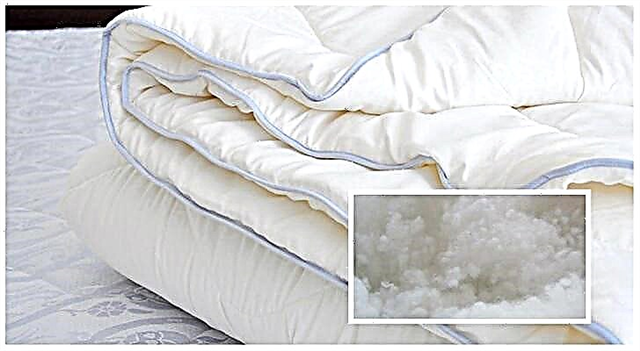
Most of the latest generation of artificial fillers are made of polyester fiber, such as holofiber, comfort, eco-fiber, silicone fiber, microfiber. They differ in appearance, but their main qualities are identical.
- Hypoallergenicity. Polyester fillers are absolutely harmless to human health.
- Elasticity. Artificial fibers hold their shape well, do not roll and do not clump.
- Low thermal conductivity. Thanks to the hollow structure, polyester fillers perfectly retain heat.
- Light weight. Synthetics are not much heavier than fluff.
- Ease of care. All these materials are easy to wash and dry quickly.
- Durability. The service life of polyester fillers is at least 10 years.
- Zero hygroscopicity. Artificial materials do not absorb moisture well.
- Electricity. These blankets quickly accumulate static electricity.
Synthetic fillers of the latest generation can be a good substitute for products made from natural fillers. The question of which blanket is better to buy when choosing from a variety of polyester fibers is not critical. Their consumer properties are about the same.
Bamboo fiber
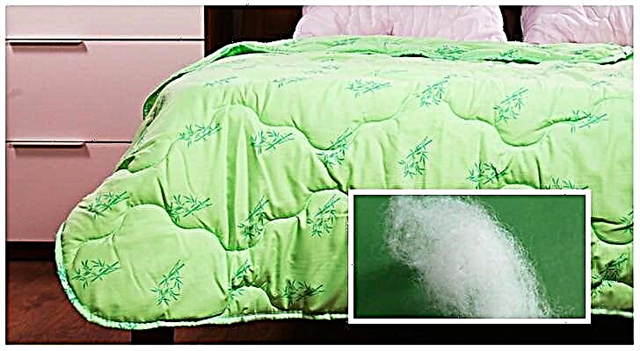
Plant fillers confidently conquer the modern market. One of them is regenerated cellulose obtained from bamboo stalks.
- Hypoallergenicity. Bamboo does not cause an allergy itself and pathogens do not start in it.
- Breathability. This filler "breathes" and has good thermoregulation.
- Environmental friendliness. Bamboo blankets are not electrified and do not absorb odors.
- Ease. The average weight of bamboo blankets is comparable to the weight of synthetic products.
- Simple care. Bamboo blankets are machine washable.
- Low warming ability. These blankets are not very warm.
- Fragility. Bamboo filler serves no more than 2 seasons. To increase the wear resistance, artificial fibers are added to it.
- Poor moisture exchange. A mixture of bamboo and synthetic fibers does not absorb moisture well.
Bamboo is one of the most environmentally friendly. They will provide a comfortable sleep in the warm season and off-season.
Eucalyptus fiber (tenzel, lyocell)
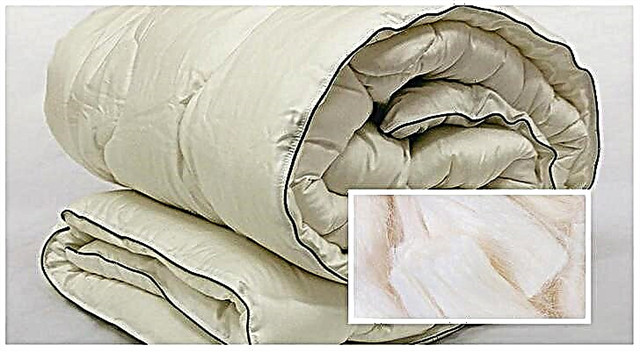
Tenzel or lyocell is another new plant filler. It is produced from regenerated cellulose obtained from eucalyptus stems.
- Hypoallergenicity. Eucalyptus does not cause allergy itself and pathogenic microbes do not multiply in it.
- Low thermal conductivity. Eucalyptus filler is the warmest of plant materials.
- Elasticity. Tenzel (lyocell) holds well and restores shape.
- Breathability. The eucalyptus blanket “breathes” and has good thermoregulation.
- Good moisture exchange. Eucalyptus filler perfectly absorbs and evaporates moisture.
- Antistatic. Eucalyptus does not accumulate static electricity.
- Simple care. Eucalyptus blankets do not lose their properties after machine wash.
- Durability. The service life of such blankets is up to 10 years.
- High price. Eucalyptus blankets are some of the most expensive in their segment.
Eucalyptus fiber has excellent thermoregulation and is suitable for all people. When buying it, you should carefully study the label, because to reduce the cost of natural fiber is often mixed with artificial materials.
Blanket Filler Rating
Among home textile products, it is difficult to immediately make a choice in favor of something specific. In addition to the reliability of manufacturers, one should rely on quality, performance, reliability and durability. Leading experts identify several determining criteria for choosing a blanket for filler:
- The degree of warmth is on a scale of 1 to 5 for different seasons,
- Comparability of the filler with the cover - volume to tissue density,
- The size of the blanket is for children, single, double or euro,
- Hypoallergenicity - naturalness,
- Breathability - how much the material can “breathe”,
- Other characteristics - moisture exchange, shape retention, etc.,
- Features of care - cleaning, processing, drying.
Since the budget is the determining factor for most buyers, the degree of high cost and the price-quality ratio were taken into account. User reviews became useful, which from personal experience were convinced of the strengths, weaknesses of different materials for sleeping.
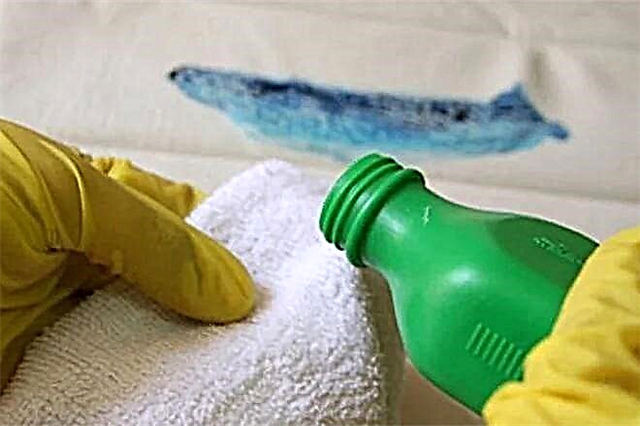
Best Blanket Fillers
Each filler has a different degree of density, thickness, heat. The choice depends on personal preferences, season of the year and quality. Preference was given to fillers that keep their shape well, unpretentious in matters of care. On sale you can see more than a dozen varieties of materials, but in 2020, 10 nominees were recognized as the best. They were selected based on user reviews, expert advice, and testing.
Synthetic winterizer
The cheapest artificial blanket filler is a synthetic winterizer. First of all, by accessibility, to modest price tags, they buy it most often. Inside it are specially processed polyester fibers, which are characterized by a minimum weight, a good degree of heat conservation. Another distinctive characteristics are high elasticity, flexibility, the ability to take any form and immediately return to its original position. Artificial material is always tested before it goes on sale to obtain a safety certificate.

Advantages:
- Ease of care
- Long life
- Cheap price tag
- High elasticity,
- Minimum weight.
Disadvantages:
- Withstands temperatures up to -10,
- Weak air circulation.
Before buying, you need to consider that there is glue in the composition, this applies to people prone to allergies. You can clean the synthetic winterizer manually or in dry cleaning, a washing machine can damage the fibers. Of the minuses, it is noted that in severe frosts this is not the warmest blanket, and in warm weather, air circulates poorly under it, because of this you can sweat.
Hollofiber
Among the inexpensive synthetic models, the best blanket fillers are made from holofiber. Its strongest quality is a high degree of resilience. The high-tech process creates well-twisted fibers in the form of springs, due to which the bedspread easily takes its original shape, no matter how it is folded. The sinuous structure is soft even under the weight of a person, it holds heat well, is not blown by the wind. High resistance to burning, ignition is noted. The material does not absorb odors, non-toxic to the human body, safe with certification.

Advantages:
- Resistance to tearing forces,
- A light weight,
- High resilience
- Good heat dissipation
- Resistance to ignition,
- Ease of care.
Disadvantages:
- Service life 5-8 years,
- The need for manual whipping.
Even children's clothes are filled with such material, which indicates the safety of holofiber. It can be cleaned, keeps its shape well, promotes comfortable sleep.
The downside is the tendency to caking, loss of splendor. To extend the service life, it should be beaten regularly by hand.
Cashmere
In the category of elite blankets, the first positions are occupied by those that contain cashmere inside. We are talking about fluff, which is manually collected from Kashmir goats. These finest fibers can create small air chambers within themselves, making the fabric “breathe” perfectly. Under such a blanket, you can warm up in the cold season, not to sweat in the summer. Despite the small weight, it is still felt that you are sleeping securely covered. Even after a decade, the tissue will not stray, roll into lumps, wrinkle. Hypoallergenicity is due to 100% natural composition. High functionality does not allow ticks, fungi, and other pathogenic microorganisms to start inside.
Advantages:
- Adaptability to temperature differences,
- Ease,
- Good thermoregulation,
- Ability to "breathe"
- Hypoallergenic
- Long service life.
Disadvantages:
The service life of cashmere exceeds 10-12 years, if all the details of caring for it are observed. Most often, such bedding is bought for children with restless sleep. Under such a blanket it will not work to freeze, sweat. But due to the difficulties of getting fluff, the price tag will be much higher than other offers.
Cotton
The most common natural material at a low price is cotton. Thanks to modern technology, it is involved in the production of bedding, as a “stuffing" for them. High thermoregulation makes cotton appropriate in the cold season, summer heat. Of the few warm tissues, it provides maximum “breathing” to the skin of the body, preventing sweat. Along with high strength, a long service life can be expected. Such bedspreads can often be washed so that dust does not stagnate inside. Hand-combed cotton is the best quality.
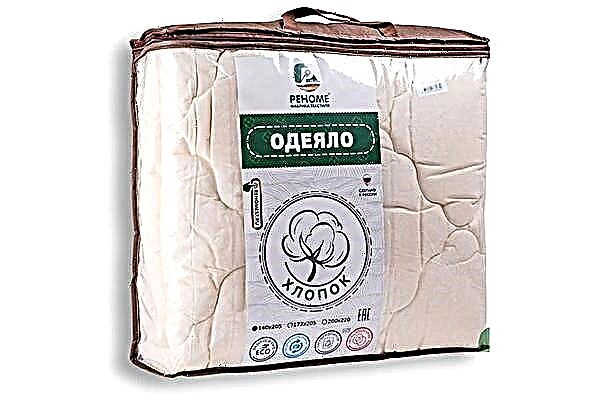
Advantages:
- Hypoallergenic
- Low thermal conductivity, heat retention,
- Inexpensive price tag
- Wide availability
- Long service life.
Disadvantages:
- It absorbs moisture, but dries for a long time,
- Heavy weight.
A small addition of synthetics is necessary to extend the service life. Cheap products can retain functionality for over 10 years. Pure cotton crumbles faster, loses a presentable appearance. In summer, such bedding is not always appropriate, dense fabric quickly absorbs moisture, but should dry out. The downside is considered a lot of weight, comparable to cotton blankets.
Another natural widespread material is flax. Modern technology allows you to create a "stuffing" for bedding with a maximum service life. Of the total weight of the blanket, linen absorbs only 12% moisture, which is significantly lower than that of cotton. At the same time, thermoregulation is not worse at all, which makes such an option popular. The fibers do not absorb odors, are not electrified, are resistant to moths, ticks. It is impossible to rub, sweat, freeze under it. Flax is recommended by dermatologists for people with allergies, asthmatics, often suffering from SARS, since dust particles do not get inside the structure.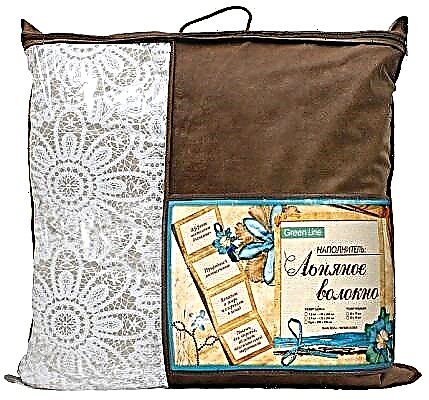
Advantages:
- Durability,
- Hypoallergenic
- Antibacterial properties
- High moisture exchange,
- Breathability
- Low thermal conductivity
- Ease of care.
Disadvantages:
- High price,
- Strongly wrinkles after cleaning.
To keep the flax in good condition, it is important to follow all cleaning rules, iron, manually break the fibers so that they do not stray into lumps. Despite the apparent simplicity, the price of such a product will be significantly higher than many other offers. This is due to the long service life, environmental friendliness.
Which blanket filler is better to buy
Each type of "filling" for bedding has its own characteristics, strengths and weaknesses. Synthetic analogues will cost less than natural ones, but the latter are hypoallergenic and environmentally friendly. Which filler for the blanket is better, I will tell you the following results of the top rating:
- The warmest filler for harsh winters is cashmere,
- Filler for people with a problematic spine, joints - sheep’s wool,
- The cheapest filler is sintepon,
- Maximum service life - flax,
- The best antibacterial properties are bamboo.
The warmest bedding contains fluff and wool. A great alternative to them will be the "filling" of plant fibers, but they are more suitable for a cool or warm season. Synthetic variants of the latest generation have high consumer properties. Before choosing which blankets it is better to buy, with which filler, it is important to familiarize yourself with the characteristics, care requirements, reviews.
Cost
The most expensive is a duvet. To fill the product using various types of fluff. This feature determines the final cost of a duvet. You should be wary of low prices - this indicates the presence of artificial filler.
A cheaper option is a woolen blanket. The cost of such a product is due to the type of wool used. This feature affects the thermal performance of the blanket.
Models with cotton (wool) filling have an affordable cost. Such products are among the most affordable solutions on the market today.
It should be noted the ambiguity of the situation with blankets made of synthetic filler. Such products are significantly cheaper than down and wool counterparts, but are presented in a wide price range. Synthetic models that are too cheap have a limited life, however, they will provide high-quality heating.
Thermal qualities
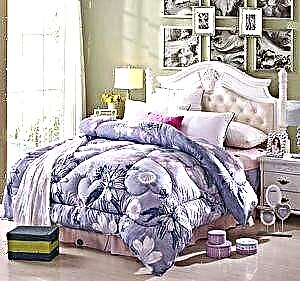 Duvets perfectly retain heat and provide effective thermoregulation. As a rule, such products are stuffed with goose, duck or eider down.
Duvets perfectly retain heat and provide effective thermoregulation. As a rule, such products are stuffed with goose, duck or eider down.
Woolen blankets absorb moisture well, preserving “dry heat”. Under such a blanket, the body will not sweat due to the maintenance of a stable temperature.
The thermal characteristics of cotton blankets are inferior to the above counterparts. Despite this, such products are among the most popular solutions. The characteristics of cotton blankets have been tested for centuries of use.
Modern synthetics provides good body ventilation and demonstrates satisfactory thermal performance.
Ease
Duvets are lightweight (less than 1 kg). This is one of the main advantages of this type of blankets - they are almost not felt on the body during sleep.
Woolen bedding weighs several times more, which can become a source of discomfort during sleep. Moreover, they are more compact than down models due to the smaller volume of material used with identical thermal characteristics.
Cotton blankets are among the most difficult bedding. At the same time, even the most voluminous model provides effective ventilation.
Synthetic-filled blankets can compete with downy counterparts for ease. The winter version of such a product weighs no more than 1 kg. However, the lighter the model, the worse its thermal characteristics.
Durability
If the duvet is properly maintained, the life of the product can exceed 20 years. Qualitative models do not change their characteristics and appearance.
Wool blankets are highly durable and well tolerate loads. They are dry cleanable and some models are washable.
The durability of a cotton blanket is quite long. However, this is relevant provided that regular and proper care is taken, which can be quite problematic.
High-quality synthetics do not slip and perfectly maintains the given shape. The decision to buy the cheapest model is wrong, since such products have a limited life.
Easy care
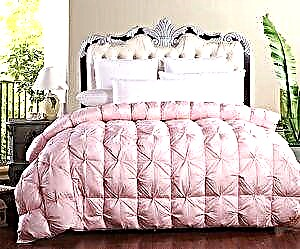 If you want to keep fluffy duvets fluffy, they must be handled extremely delicately. Do not lie or sit on the product for a long time. Neglect of this recommendation will result in a crumple of fluff. To maintain shape, the product must be whipped and ventilated regularly.
If you want to keep fluffy duvets fluffy, they must be handled extremely delicately. Do not lie or sit on the product for a long time. Neglect of this recommendation will result in a crumple of fluff. To maintain shape, the product must be whipped and ventilated regularly.
Woolen blankets are easy to clean. They are easy to wash and clean. Keeping such a product clean will not be difficult.
The most complex and whimsical cotton blankets. They require special conditions for washing, cleaning and drying, which can be quite tiring.
The easiest way to take care of a synthetic blanket. The product can be washed in a washing machine at a temperature of 60 o C.
Conclusions
The main advantages of duvets include light weight and high thermal performance. This is the best way out for those who cannot stand the pressure of a heavy blanket in their sleep. If you are prone to allergies, synthetic filler should be preferred. A cotton quilt shows the worst hygiene performance.
The choice of down filler
Now 3 types of fluff are used, which differ in price, thermal characteristics and mass:
- Duck. Cheap low-quality heavy down with stiff fuzz axes. It is the least warm and is found exclusively in inexpensive blankets.
- Goose. Better, lighter and not stiff fluff with high thermal characteristics. There are several gradations of quality of this filler - world, European and the best - Swiss.
- Eider. This type of fluff is one of the most expensive solutions and has the best thermal characteristics.
If you are offered a “swan” fluff, you should know that this is a synthetic fiber, not a natural material. It holds well and is easy to care for. However, its thermal characteristics are inferior to the fluff of the northern eider.
Avoid models in which the proportions of fluff and feather are biased in favor of the latter. They will not warm well, and will also become a source of discomfort during operation and maintenance.
Features of choosing a duvet
Natural fabric models deserve increased attention. She will breathe well, but she will not let the fluff out. Unfortunately, such a blanket will require significant financial costs. However, the quality and durability of such a product will fully justify the investment.
Among the most popular solutions are cassette-type models. The location of the fluff in separate sections-cells prevents rolling. This airy and voluminous blanket has an extended service life.
When choosing the density of the product, it is necessary to focus on the average winter temperature in the room where the blanket will be used. A wide range of solutions allows you to choose universal models, as well as bedding, designed for different seasons.
Experts recommend paying increased attention to the choice of blankets for the child. It is better to purchase 2 models - for the winter and summer. If desired, the summer blanket can be replaced with a good down scarf.
If the baby is prone to allergies, natural materials should prefer high-quality synthetics or hypoallergenic fillers.
Care Features
Before you start cleaning, you must examine the product label, and also find out if you can use the washing machine. It is recommended to wash the blanket in the last days of a hot August, using a delicate mode. This is due to the fact that in the cold season a person sweats less than in summer. The same tips apply to a down pillow.
A pair of tennis balls placed in the drum of the washing machine along with a blanket will help to avoid stalling down. But using the automatic spin option will increase the likelihood of damage to the filler.
Drying the product is recommended in a shaded place. The product should be laid out horizontally and shaken periodically.
To save personal time, you can give the product dry cleaning. After professional washing, the blanket should be whipped daily and aired once a month.
Types of Cotton Blankets
Cotton-filled blankets come in many sizes and types. To determine the desired size, take into account the parameters of the bed, individual preferences. The product should not hamper movement during sleep. There are such models:
- double (1.72 per 2.05 m), double European-style (2 per 2.2 m), one and a half (1.4 per 2.05 m), children (1.1 per 1.4 m, 1.4 at 1.4 m.), non-standard parameters.
By the method of sewing, the following varieties are distinguished:
- A quilt. These are cotton-filled products that attach with a quilting. It is in great demand among buyers. Quilted quilts give warmth and comfort even at low temperature conditions.
- Karostepnoe. It is characterized by good thermal insulation. Blankets are made by hand, have a complex pattern.
- Cassette It costs more than the above models. It’s harder to care for. It consists of separate sections that are filled with cotton. Partitions prevent material from moving.
Blankets made of batting are also distinguished by such indicators: composition of fibers, thickness, density, color, manufacturing method. Cotton wool filler can be made from both natural and artificial materials.
What a batting blanket consists of
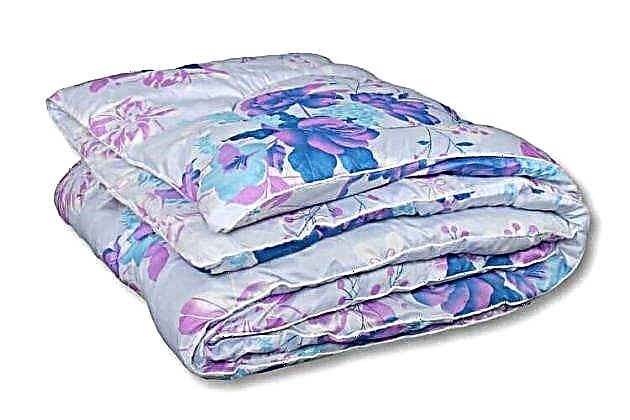
The most expensive models are made from natural materials:
- 100% wool. Use non-combustible yarn of high quality. Products weigh more than cotton. Perfectly absorb moisture. Heat resistant models. From 100% cotton. With a long service life. They are characterized by ease of care. From flax. It is made from waste (short fibers) that remain in the flax spinning industry.
A batting blanket is cheaper, where viscose or polyester fibers are used as a filler. It does not crumple. These are more lightweight products.
Attention. Great demand among buyers is used in models consisting of 30% wool and 70% viscose, cotton or synthetic materials.
There are 3 types of raw materials:
- secondary sewing, cotton sewing, cotton sewing (I grade).
For the production of blankets, cotton wool of special quality is taken. It is resistant to the influence of external factors, not stratified. On sale there are products with technical fiber or filler after regeneration.
Models are made from 3 to 12 millimeters thick.
An important indicator is the density, which is in the range of 90-1000 grams per square meter. The higher the density, the heavier the product. It is better to choose a product with an average value (from 200 to 400 g / m 2).
The filler made of cotton is yellow, white or gray. Wadding made of gray wool. When the material is made of colored yarn, it is painted in multi-colored tones.
There are many colors and colors of blankets. The product can also be used without a duvet cover. Covers are sewn, as a rule, from natural fabrics. Both monophonic models, and with an unusual ornament, drawings are popular.
Manufacturing methods
According to the manufacturing method, batting can be non-woven and knitted. The basis used wastes from the clothing and weaving industries. Fibers of both natural and artificial origin are processed to form a loose structure and a fluffy look. Then the hairs are evenly placed and fastened using special equipment.
- Knitting firmware. Small threads are decoratively joined by parallel Christmas-tree-like stitches. Such material is also called canvas batting. Sew with a dense artificial or cotton thread. Differs in durability. Needle Punch. With the use of densely placed needles that fasten the hairs with stitches vertically. This cotton wool is also called needle-punched non-woven material. Low cost is associated with a relatively short period of operation.
The most high-quality and expensive batting is planted on gauze. A product with such a filler is protected from deformation. Thus, the period of use is significantly extended. It is desirable to choose products from trusted manufacturers whose products meet GOST.
Care Tips
A cotton blanket should be often ventilated so that excess moisture evaporates. It is advisable to do this in a draft in dry weather. Avoid exposure to sunlight.
The product can be dry cleaned or simply vacuumed. Due to the large weight, it is difficult to wash. This is especially true for double models.
How to wash a cotton blanket at home
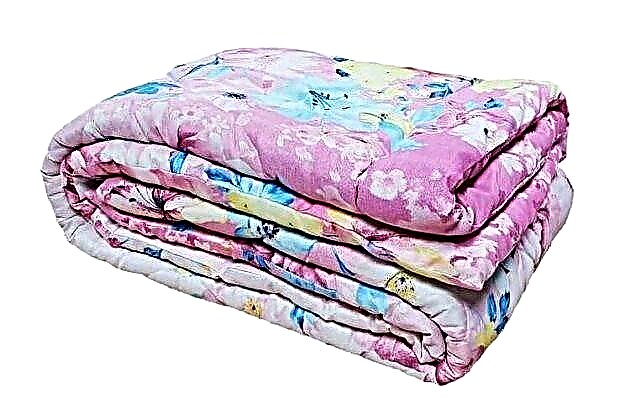
It is better to carry out the procedure in the summer, when the thing dries quickly. Pre-knock or vacuum cleaned.
Soak a thick cotton blanket entirely only in case of emergency, when there is an unpleasant strong smell or pollution of an organic nature.
If necessary, you can wash your hands with large quilts. In time, this is a lengthy procedure, for which you will need:
- laundry soap, water heated to a warm temperature, foam brush or sponge, liquid detergent, stain remover without aggressive components.
The blanket is laid out horizontally on a straight surface. A soap solution is prepared from water and liquid powder. If necessary, heavily contaminated areas are treated with laundry soap or stain remover. Apply the foam on two sides with a brush or sponge made of foam rubber. Clean water is washed until the foam disappears completely. It is impossible to twist. It is better to get wet with a dry cloth.
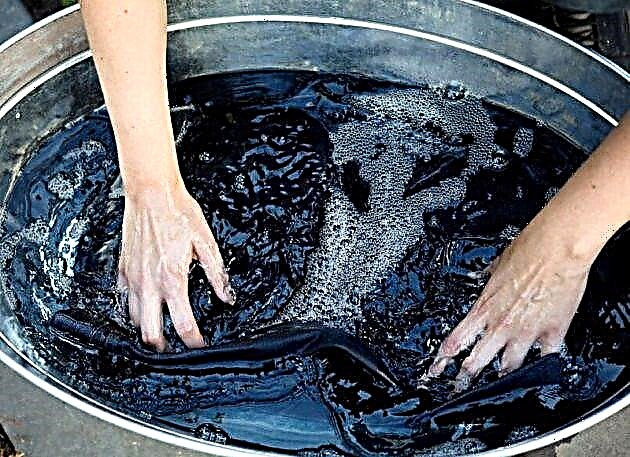
For those who are interested, is it machine washable? Yes, but only small in compliance with certain rules:
- liquid detergents should be used, they are easier to rinse and do not leave marks on the surface, small baby blankets can be machine washed in delicate mode, the spin function cannot be used, the water temperature must not exceed 30 degrees, tennis balls or special balls must be put in the drum balls that are used when washing down items.
There is an alternative method of cleaning using steam, which is considered gentle. Not only spots disappear, but also disinfection from bacteria, ticks, and moth larvae occurs. The procedure is carried out with a steam generator or an iron with a steaming function. This method helps eliminate odors.
During drying in the sun, the blanket is covered with a thin cloth. You can’t hang on a rope to avoid deformation. The dry product must be vacuumed again to remove any powder residue.
Manufacturers of cotton blankets recommend changing the product every five years, because often favorable conditions are created for the growth and reproduction of bed mites.
Having familiarized with the pros and cons of the product, as well as how to wash a cotton blanket, each consumer can decide for himself how much the product suits him.
Hemp fiber, flax
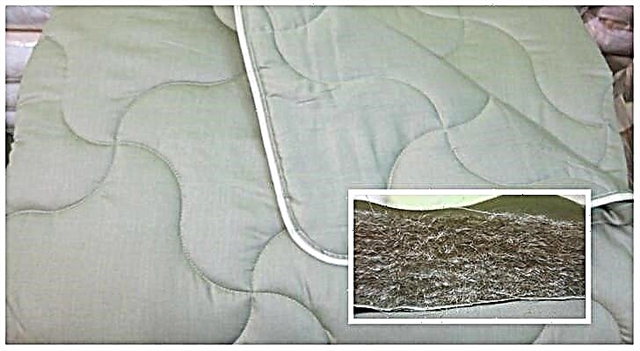
Hemp and flax are natural plant fillers that are becoming increasingly popular and are successfully competing with expensive silk.
- Hypoallergenicity. These fillers do not cause allergies, skin irritations and dust mites do not live in them.
- High breathability. Air circulates freely inside them, creating a comfortable microclimate under the covers.
- High moisture exchange. Flax and hemp quickly absorb excess moisture and then evaporate it, remaining dry.
- Antibacterial. Due to the presence in the chemical composition of hemp and flax selenium and silicon, pathogenic microbes do not multiply in the blankets from them.
- Low thermal conductivity. Flax and hemp fibers have high warming properties and excellent thermoregulation.
- Durability. These excipients last longer than any other natural plant materials.
- Easy care. These blankets are easy to wash and dry quickly.
- High price. The cost of these fillers is much higher than bamboo and eucalyptus and second only to silk products.
- Hypoallergenicity. This is the only filler of animal origin in which dust mites and fungi do not start.
- Antibacterial. Silk is a good antiseptic, therefore, pathogenic microorganisms do not multiply in it.
- High moisture exchange. Silk perfectly absorbs and evaporates moisture, creating a comfortable microclimate under the blanket.
- Durability. The service life of silk blankets is at least 12 years.
- Breathability. Air circulates freely through silk hairs. The greenhouse effect under such a blanket is excluded.
- Antistatic. Natural silk is not electrified and does not accumulate static electricity.
- Easy care. Silk blankets do not need to be washed often. It is enough to air them from time to time.
- High thermal conductivity. Silk blankets are only suitable for summer and off season.
- High price. The cost of such blankets is comparable to the cost of down products.
Linen and hemp blankets are suitable for all people, without exception. They can be used at any temperature in the room, and their high price pays off for many years of use.
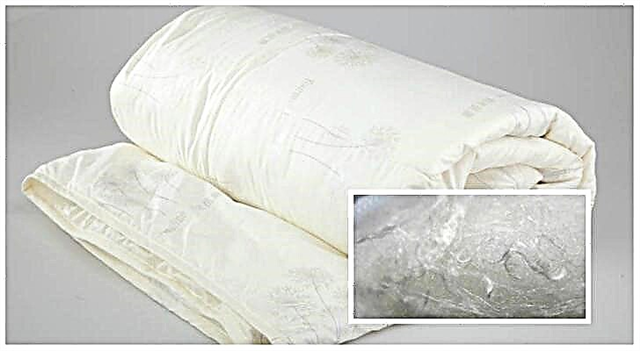
Silk is a blanket filled with fluffy fibers produced by silkworm larvae.
A blanket filled with silk is quite expensive and will not work in the cold season. It is best used in the summer or in the off-season, when the temperature has not yet dropped much.
Selection tips

Woolen and downy products are the warmest, their quality has been tested for centuries, but for many people they cause allergies. To exclude it, it is necessary to periodically carry out their anti-mite treatment, dry and ventilate as often as possible.
Blankets made of silk and plant materials will be a good alternative to down and wool products for people who prefer natural materials, but are prone to allergies. Given that the warming ability of silk and bamboo blankets is low, it is not recommended to use them in winter frosts. Products made from flax, hemp, eucalyptus and cotton are more suitable for cold weather.
Consumer properties of synthetic blankets of the latest generation are very high today. The only indicator in which they are seriously inferior to natural products is insufficient moisture exchange. To prevent overheating, hiding in such blankets, you should select their density according to the season.
Before buying, carefully study the properties of the filler, find out the opinions of friends who already use a similar blanket. This will help you make the right choice, and sleep healthy and sound.

